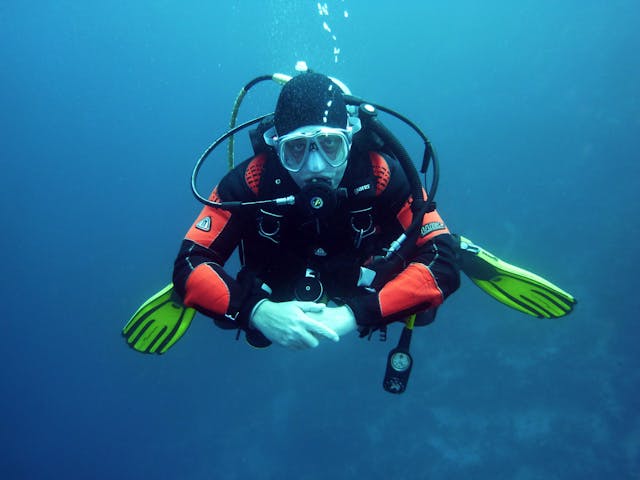
What causes the bends? It is caused by the rapid release of nitrogen gas from the bloodstream.
You don’t have any risk of the bends if you don’t go very deep. The bends becomes a risk if you dive any deeper than about 9 meters. It is caused because of the water pressure and because of the gases that we breathe.
When we are on the surface, we breathe in air which is 78% nitrogen and 21% oxygen, plus one percent of other gases. Nitrogen is a nonreactive gas and our body can’t use it for anything so we breathe out all of the nitrogen that we breathed in. If you hold your breath and jump into a swimming pool, your lungs will be full of oxygen and nitrogen. You will use some of the oxygen and when you resurface, you’ll breathe out what’s left of the oxygen, plus carbon dioxide, and all of the nitrogen. However, if you go deeper than a swimming pool, things start to change.
As you go deeper into the water, the pressure begins to build up. When we are on the surface of the water, we have a pressure of 1 atmosphere. All of the weight of the air in a column above us is compressing us and this is 1 atmosphere. We have evolved to live, breathe, and do everything that we do with that much pressure. As you go deeper into the sea, the pressure increases by 1 atmosphere for every 10 meters. That is why people don’t usually suffer from the bends if they are only diving down to about 9 m. If you go down to 20 m, you have a pressure of 3 atmospheres, which means that you will be experiencing three times the pressure you had at the surface.
Our lungs have evolved to take air in at the pressure we have on the surface. When you lower your diaphragm, it creates a vacuum and air is sucked into your lungs. If you are 20 m deep in the ocean and you try to breathe regular air from a tank, you wouldn’t be able to suck it in because the weight of the water pressing down on your chest would be too great for your lungs to inflate. You would suffocate. The only way to be able to breathe at that depth in the water is to use pressurized air from a tank. The air has to be pressurized to the same pressure as the depth you will be diving to. That is the only way you can breathe it in.
As you dive deeper and you breathe air that is a higher pressure, the nitrogen in the air you are breathing starts to become soluble in the blood. High pressure can make many inert gases soluble. Oxygen doesn’t have this effect because use it for the processes in our bodies, but nitrogen is an inert gas, and it starts to build up. The soluble nitrogen builds up in the blood and it spreads around the body where it is stored in the muscles and in different parts of the body. This process can make people sick and divers that are going to great depths will have to go down slowly, acclimatizing as they go.
The bends happens when people who have been deep in the sea come back to the surface too quickly. At depths, the nitrogen is dissolved in the blood and muscles, but when they come up and the pressure drops, the nitrogen reverts back to a gas and forms bubbles. Having bubbles of gas in the blood stream and in the muscles can be extremely painful. The bubbles can get into joints and they cause severe pain, doubling people over, which is where the name “the bends” comes from.
The way to avoid the bends is to surface very slowly. Deepsea divers have a dive calculator which tells them how quickly they can surface, and they may have to spend a while at different depths. Doing this gives the nitrogen in the blood a chance to clear out of the body. Very deep sea divers, such as the saturation divers who live for over a month in pressurized quarters and work on the bottom of the sea, have to spend many days resurfacing. It takes a long time to shift the inert gases out of the body and reacclimatize.
If someone comes up too quickly and ends up with the bends, they can be put in a hyperbaric chamber, which can be pressurized to dissolve the nitrogen in the blood again. Then it can very slowly be repressurized. The bends can be treated, and it often has no lasting effects, but it is extremely painful. If left untreated, it can be fatal. And this is what I learned today.
Photo by Pixabay: https://www.pexels.com/photo/human-in-black-orange-swimming-suit-in-blue-body-of-water-37530/
https://en.wikipedia.org/wiki/Decompression_sickness
https://www.atlasobscura.com/articles/what-is-a-saturation-diver
https://www.health.harvard.edu/a_to_z/decompression-sickness-a-to-z
https://www.wired.com/story/the-physics-of-scuba-diving/
https://en.wikipedia.org/wiki/Henry%27s_law
